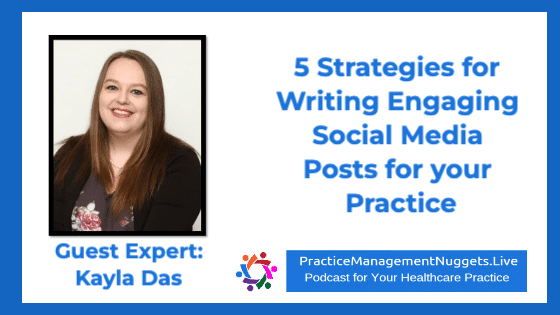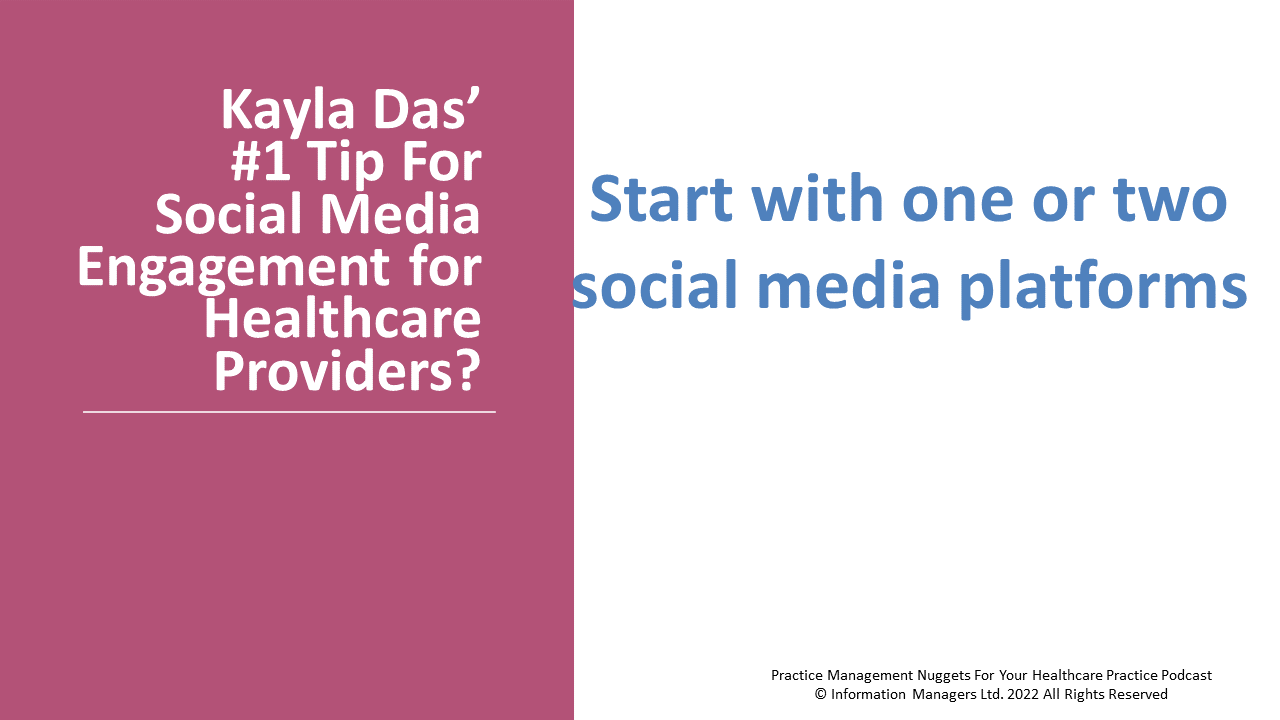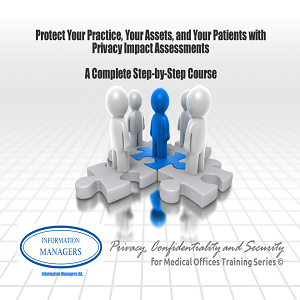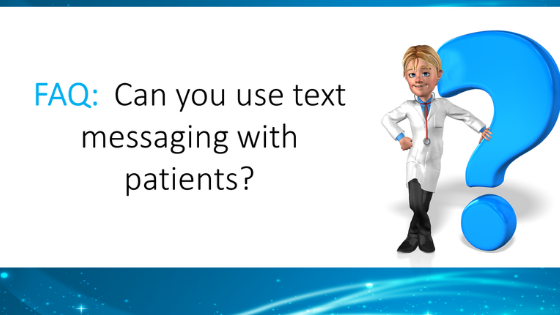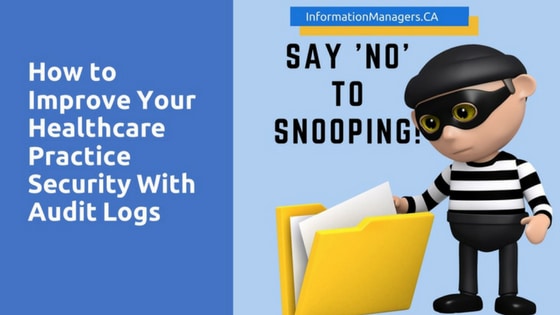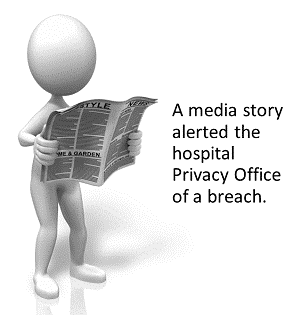Do you need a Privacy Impact Assessment?
Or do you need to amend an existing PIA?
Privacy Impact Assessments are just one of the requirements you need in order to fulfill your obligations in Alberta’s Health Information Act (HIA) and other legislation and are an important aspect of developing privacy best practices in your office.
And a little help along the way is always a good thing.
Practical Privacy Coach, Jean L. Eaton of Information Managers, is constructively obsessive about privacy, confidentiality, and security when it comes to the handling of personal and health information, particularly in primary health care settings. Jean has helped hundreds of healthcare providers, vendors, and health and social service delivery organizations and associations complete their Privacy Impact Assessment which have been successfully accepted by organizations’ management and regulators. Jean has customized and delivered privacy training programs for privacy officers, records management professionals, implementation teams, and healthcare providers across Canada and the US.
Now you can have access to five modules to help you learn everything you need in order to complete your own PIA.
[s3vpp id=3a4b10b9e627f27da781cdb590b784cf]
**** New PIA Amendment Track ****
Each module includes a video training, as well as templates, tools, resources and case studies to build on in each lesson. You can use this scenario to guide you through the PIA process in healthcare. If you work in healthcare or privacy or records management and need to do a PIA, this e-course is for you.
You need a Privacy Impact Assessment (PIA) when
- You are opening a new clinic or establishing a new health services program.
- You are changing administrative procedures or technology equipment, services, or vendors
- You are changing how you collect and use personal information,
- You are implementing or changing an Electronic Medical Records (EMR)
- You are sharing health information with another healthcare provider, organization, Primary Care Network or other health program.
- You want to prevent a privacy breach,
- You have a Privacy Impact Assessment that was written more than 2 years ago (It is time to review and update this!)
If you are a healthcare provider, practice manager, and you need your first Privacy Impact Assessment, this e-course is for you
Are you in a group or solo practice with direct patient care, for example:
- Physician
- Pharmacist
- Registered nurse
- Optometrist or optician
- Chiropractor
- Physiotherapist
- Midwife
- Podiatrist
- Dentist, dental hygienist or denturist
- Audiologist
- Mental health practicitioner
- Laboratory, x-ray, and imaging technician
- Paramedic
A PIA should be as common place to a healthcare practice as a business plan is to a business. BUT most healthcare practices don’t know this and often don’t know that a PIA is usually part of their professional college requirements and often even a legislated requirement! Prevent malicious errors, omissions or attacks that could result in fines and even jail time for the business, healthcare provider, employee, or vendor by completing a PIA.
If your Privacy Impact Assessment was written more than 2 years ago this online on-demand course is for you!
The Clinic Manager and Physician Lead and Privacy Officer must ensure its content is updated to reflect the current state of administrative, physical and technical controls.
BONUS! Checklist to update your PIA to meet recent changes to Alberta’s Netcare Portal. If your practice has completed a PIA and now you need to update the PIA, you receive a checklist of items that you need to consider to refresh your PIA.
If you are vendor that supports healthcare practices this e-course is for you!
BONUS! One hour tele-consult with Jean, “Create a branded Privacy Impact Assessment Readiness Package”. Jean will work individually with you to review your documentation and coach you on how to prepare the package to give to healthcare practices.
BONUS! Vendor PIA live webinar includes Vendor non-disclosure agreement, Information Manager Agreement, GAP Analysis, Computer Network Narrative templates.
Jean has helped hundreds of physicians, chiropractors, pharmacists, and other healthcare providers complete their Privacy Impact Assessment. She has visited hundreds of practices across Canada. But time and geography limit my ability to visit each healthcare practice that needs a PIA. That’s why I developed this on-line interactive course to help you learn everything you need in order to review, amend, or create your own PIA. Each module includes a video training as well as templates, tools, resources and two common case studies to build on each week. You can use these scenarios to guide you through the PIA process.
You know your practice better than anybody else. If you had the right tools, at the time most convenient for you and a mentor to help you, you can develop good office practices, meet legislated and college requirements, and successfully complete your Privacy Impact Assessment requirements.
Using a Webinar on-line interactive program, you will get great content and mentoring from Jean Eaton and once a month during the Q&A live training webinars. Learn the PIA process with these modules.
The modules include:
PIA to Protect Your Practice, Your Assets, and Your Patients
Information Flows–-the Foundation of Your PIA
Risk Analysis and Mitigation Strategies
PIA Format – Pulling it All Together
Complete Your PIA Submission
Create a Branded Privacy Impact Assessment Readiness Package
The replays, tools, and resources will be available to you right away.
If you are new to this field, I suggest that you first register for Privacy Awareness in Healthcare: Essentials to master the key definitions and concepts.
Corridor Interactive
Protect Your Practice, Your Assets, and Your Patients with Privacy Impact Assessments –
A Complete Step-by-Step Course
5 Core Modules, Templates, Training, and Tools to Get Your PIA Done!
Monthly Live Q&A Training Webinars
$450.00 (plus GST)

You will get
- Learning Resource Guide for EACH module – how-to explanations, templates, and resource lists
- Checklists to help you plan your PIA
- MindMap of the entire PIA process
- PIA project plan timeline templates
- Checklists of personal and health information privacy and security policies that you need in your practice
- Many examples of projects in medical, dental, chiropractic and more practices including new PIA project and PIA amendments.
- Explanation and real-life examples of key terms that you need to know and include in your PIA
- Strategies and templates of risk management assessments that you can customize
- This E-course might qualify for CPE credits, too!
BONUS! Monthly live Q&A webinar training with Jean to help you get un-stuck with your PIA.
BONUS! Checklist to update your PIA to meet recent changes to Alberta’s Netcare Portal.
BONUS! Private discussion group with other registered participants of this course to network and support each other on your PIA journey and continue to help you after this course closes.
BONUS! Regular updates of privacy resources and templates that you can use.
If you hired a consultant to do the work of the PIA process for you it may cost you as much as $3,000!
And then…when the consultant is done, they take their knowledge out the door with them.
Invest only $450 in this course and you’ll have what you need to do your first PIA project today…and every project in the future!

I had the pleasure of working alongside Jean to develop a PIA for my Dental Office. I could not have completed this document without her. She was there to help me every step of the way. Her online course made it easy to communicate with her as well as having so many resources to use that were so helpful. Each Module had videos to watch that explained step by step what needed to be done. The PIA document is a lot of information to put together and if it’s not enough information on its own, you also need to develop a policy and procedures manual. Jean has developed an amazing resource for this manual that was very user friendly and made a 300 page manual a lot more attainable than creating it on your own. I highly recommend taking Jean’s PIA course and having her help throughout the process!”
~~Lindsey Cave, Office Manager, Orion Dental Group
What people are saying about our PIA e-courses and in-person workshops:
Q: What did you learn from this workshop?
Participant’s Responses:
- Understanding of need / use of Information Management Agreement’s and an ‘Evaluation” agreement.
- Lots – when / how to make amendments.
- Compliance / requirements of PIA and their purpose.
- PIA information; agreements, updating.
Q: What do you feel was the biggest benefit to attending this workshop?
Participant’s Responses:
- Understanding a PIA.
- Having a better understanding of PIA’s and everything included in requirements.
- Gain a better overview of my PIA and what I need to add; organizational strategy.
- Clear vision of work to be done.
“When Jean told us about the Protest Your Practice, Your Assets, and Your Patients with Privacy Impact Assessments E-course and explained how the course will help us better understand the Health Information Act, our responsibilities as healthcare providers and our relationship with our vendors and partners, I signed up right away! Thanks again – it is no doubt that we have hitched our wagon to a shining star.”
~~Bill Stowe, Business Manager Synergy Respiratory & Cardiac Care
“I attended the Privacy Impact Assessment Walk-through workshop (for ARMA members). Jean shared resources and on-going networking opportunities. The biggest benefit to me is to know that there is help out there in moving forward with our Privacy Impact Assessment responsibilities.”
~~Ellen Sauvé, Parkland County
Comments from other E-course participants:
“Learning about how all the information gathering systems interact was the most valuable part of this workshop”
“Excellent presenter – variety of learning opportunities.”
“Jean is an excellent speaker and I enjoyed the audio seminar you gave today and I learned a lot from your seminar.”
~~Annette T (AHIMA webinar, Three Mistakes in Managing a Privacy Breach”)
“Jean Eaton is one of those ‘critical suppliers’ you keep in your email contacts list, no matter what company you manage. She really knows her stuff and delivers prompt, accurate information on time. Her courses are interesting, informative, and I like the opportunity to meet with classmates who have similar challenges.”
~~Kevin Morris, Shape MD, Team Leader/Office Manager

In-Person Workshops Are Now Available
Are you a hands-on kinda person?
Are you more likely to get things done when you schedule your time for a working meeting?
Would you like help to kick-start your PIA amendment and review with other like-minded clinic managers and privacy officers?
PIA Amendment Workshops are available. Send a request to me and let’s set up a workshop near you! You also get full access to the on-line course to support you after the workshop.

Not sure if the E-course is for you?
Jean will answer your questions in the free webinar,
Prevent Big Fines (or Worse!) for Your Healthcare Practice
How to Plan a Privacy Impact Assessment for Your Healthcare Practice
with Jean L. Eaton
Replay Recorded Live
This webinar is for Privacy Officers, Clinic Managers, Practice Managers and anyone else responsible for doing a PIA.
You will learn what is getting in your way of getting your PIA done!
In this free webinar, you will learn:
- 5 Manageable Steps of every PIA
- 3 Biggest Myths about PIA’s that is preventing you from completing your PIA
- Questions Privacy Officers, Clinic Managers, Practice Managers and Healthcare providers should ask about PIA’s but don’t
- Biggest fears about doing a PIA and how you can kick it to the curb so that you can finally get it done
Join us for the webinar so that you can plan your PIA for your healthcare practice!
Sign me up for this FREE webinar

Please provide your email address below and you will be re-directed to the webinar replay right away.
Check your email in-box to confirm your registration!
Along with your webinar registration, you will also benefit from the occasional Privacy Nugget tips by email of similar privacy resources and articles that you can use right away!




